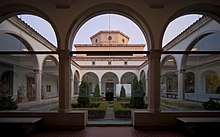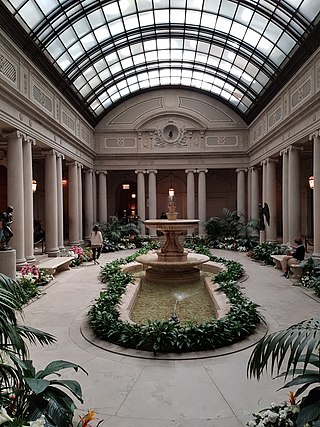
The Frick Collection is an art museum on the Upper East Side of Manhattan in New York City, New York, U.S. Established in 1935 to preserve the art collection of the industrialist Henry Clay Frick, the museum consists of 14th- to 19th-century European paintings, as well as other pieces of European fine and decorative art. The museum is located at the Henry Clay Frick House, a Beaux-Arts mansion designed for Henry Clay Frick. The Frick also houses the Frick Art Reference Library, an art history research center established by Frick's daughter Helen Clay Frick in 1920, which contains sales catalogs, books, periodicals, and photographs.

Oakland is the academic and healthcare center of Pittsburgh and one of the city's major cultural centers. Home to three universities, museums, hospitals, shopping venues, restaurants, and recreational activities, this section of the city also includes two city-designated historic districts: the mostly residential Schenley Farms Historic District and the predominantly institutional Oakland Civic Center Historic District, as well as the locally-designated Oakland Square Historic District.

The Cathedral of Learning is a 42-story skyscraper that serves as the centerpiece of the University of Pittsburgh's (Pitt) main campus in the Oakland neighborhood of Pittsburgh, Pennsylvania. Standing at 535 feet (163 m), the 42-story Late Gothic Revival Cathedral is the tallest educational building in the Western Hemisphere and the second-tallest university building in the world, after the main building of Moscow State University. It is also the second-tallest gothic-styled building in the world, after the Woolworth Building in Manhattan. The Cathedral of Learning was commissioned in 1921 and ground was broken in 1926 under general contractor Stone & Webster. The first class was held in the building in 1931 and its exterior finished in October 1934, prior to its formal dedication in June 1937. It is a Pittsburgh landmark listed in the National Register of Historic Places.

The Carnegie Museum of Art is an art museum in the Oakland neighborhood of Pittsburgh, Pennsylvania. The museum was originally known as the Department of Fine Arts, Carnegie Institute and was formerly located at what is now the Main Branch of the Carnegie Library of Pittsburgh. The museum's first gallery was opened for public use on November 5, 1895. Over the years, the gallery vastly increased in size, with a new building on Forbes Avenue built in 1907. In 1963, the name was officially changed to Museum of Art, Carnegie Institute. The size of the gallery has tripled over time, and it was officially renamed in 1986 to "Carnegie Museum of Art" to indicate it clearly as one of the four Carnegie Museums.

Carnegie Museums of Pittsburgh is a nonprofit organization that operates four museums in Pittsburgh, Pennsylvania, United States. The organization is headquartered in the Carnegie Institute and Library complex in the Oakland neighborhood of Pittsburgh. The Carnegie Institute complex, which includes the original museum, recital hall, and library, was added to the National Register of Historic Places on March 30, 1979.

The Stephen Collins Foster Memorial is a performing arts center and museum which houses the Stephen Foster Archives at the University of Pittsburgh in Pittsburgh, Pennsylvania, USA. It is dedicated to the life and works of American songwriter Stephen Foster.

Wesley W. Posvar Hall (WWPH), formerly known as Forbes Quadrangle, is a landmark building on the campus of the University of Pittsburgh in Pittsburgh, Pennsylvania, United States. At 744,695 square feet (69,184.4 m2) it is the largest academic-use building on campus, providing administrative offices, classrooms, lecture halls, a food court, and computer labs. The hall sits on the former site of Forbes Field and contains several artifacts, including the former stadium's home plate and one of two surviving Langley Aerodromes.
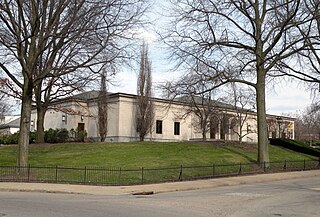
The Frick Pittsburgh is a cluster of museums and historical buildings located in Pittsburgh, Pennsylvania, United States, and formed around the Frick family's nineteenth-century residence known as "Clayton". It focuses on the interpretation of the life and times of Henry Clay Frick (1849–1919), industrialist and art collector.

The William Pitt Union, which was built in 1898 as the Hotel Schenley, is the student union building of the University of Pittsburgh main campus, and is a Pennsylvania and Pittsburgh History and Landmarks Foundation Historic Landmark.

Frederick John Osterling was an American architect, practicing in Pittsburgh from 1888.

Hillman Library is the largest library and the center of administration for the University Library System (ULS) of the University of Pittsburgh in Pittsburgh, Pennsylvania, United States. Located on the corner of Forbes Avenue and Schenley Drive, diagonally across from the Cathedral of Learning, Hillman serves as the flagship of the approximately 7.1 million-volume University Library System at Pitt.

Schenley Plaza is a public park serving as the grand entrance into Schenley Park in Pittsburgh, Pennsylvania.

The Mary Schenley Memorial Fountain, also known as A Song to Nature, is a 1918 landmark public sculpture in bronze and granite by Victor David Brenner. It sits in Schenley Plaza at the entrance to Schenley Park and directly in front of the University of Pittsburgh's Frick Fine Arts Building in Pittsburgh, Pennsylvania, United States. The fountain is designated as a contributing property to the Schenley Farms Historic District.
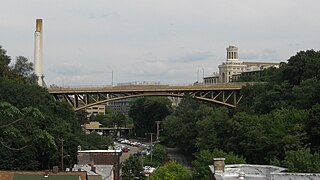
The Schenley Bridge is a steel three-hinged deck arch bridge spanning Junction Hollow in Pittsburgh, Pennsylvania. It carries Schenley Drive between Oakland on the west and the main part of Schenley Park on the east, connecting Schenley Plaza, the Carnegie Institute, and the Frick Fine Arts Building with Frew Street, Flagstaff Hill, and Phipps Conservatory. The bridge spans 620 feet (190 m) and arches 120 feet (37 m) above the hollow.
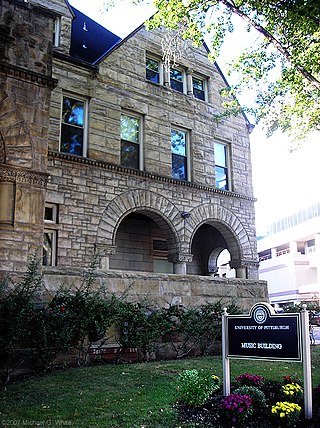
The Music Building is an academic building of the University of Pittsburgh in Pittsburgh, Pennsylvania, United States, and a contributing property to the Schenley Farms National Historic District. A Longfellow, Alden & Harlow-designed mansion that was originally the home of the pastor of a neighboring church and former university chancellor, it also served as the home to a local chapter of the Knights of Columbus, as chemical laboratories, and as the first home of educational television station WQED and that station's original production site for Mister Rogers' Neighborhood. Today it is home to the University of Pittsburgh's Department of Music and the school's Theodore M. Finney Music Library.

Helen Clay Frick was an American philanthropist and art collector. She was born in Pittsburgh, Pennsylvania, the third child of the coke and steel magnate Henry Clay Frick (1849–1919) and his wife, Adelaide Howard Childs (1859–1931). Two of her siblings did not reach adulthood, and her father played favorites with his two surviving children, Childs Frick (1883–1965) and Helen. After the reading of their father's will, which favored Helen, the brother and sister were estranged for the rest of their lives.

Thaw Hall is a historic academic building on the campus of the University of Pittsburgh that is a contributing property to the Schenley Farms National Historic District and has been named a Pittsburgh History and Landmarks Foundation Historic Landmark. The five-story building of stone, brick, and terra cotta was completed in 1910 in the Neoclassical Beaux-Arts style by architect Henry Hornbostel and today serves as space for a variety of academic classrooms, labs, offices, and centers. It is located between, and connected to, the university's Old Engineering Hall and Space Research Coordination Center (SRCC) along O'Hara Street in the Oakland neighborhood of Pittsburgh.

Bellefield Hall is a Pittsburgh History and Landmarks Foundation Historic Landmark and is a contributing property to the Schenley Farms Historic District on the campus of the University of Pittsburgh across Bellefield Avenue from Heinz Memorial Chapel and the lawn of the university's Cathedral of Learning in Pittsburgh, Pennsylvania, USA. A 1924 italianate structure by architect Benno Janssen, it originally served as a Young Men's and Women's Hebrew Association, but now houses rehearsal spaces, classrooms, offices, and a Digital Recording Studio for the University of Pittsburgh's Department of Music, as well as a university gymnasium, fitness center, indoor swimming pool, and a 676-seat auditorium.

The University Club is an eight-story building of the University of Pittsburgh designed by Henry Hornbostel and completed in 1923 that is a contributing property to the Schenley Farms Historic District on the school's campus in Pittsburgh, Pennsylvania, United States. It serves as a faculty club with publicly accessible dining, banquet, and conference facilities, while the upper four floors serve as undergraduate student housing referred to as University Hall.

The Schenley Farms Historic District, also referred to as the Schenley Farms–Oakland Civic District, is a historic district listed on the National Register of Historic Places that is located in the Oakland section of Pittsburgh, Pennsylvania, United States.


